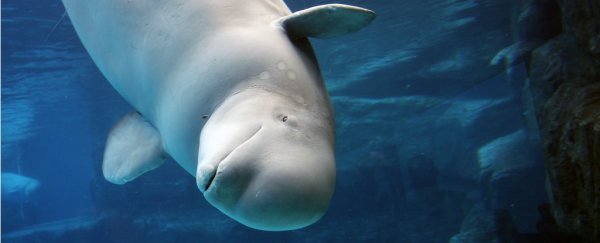Most people with ovaries go through menopause. But most animals do not, and their reproductive organs last about as long as they do. We are an outlier. So are whales.
Beluga whales and narwhals are the latest known addition to the ranks of menopausal mammals, a group of scientists reported Monday in the journal Scientific Reports.
That brings the total number of species to five: these two whales, plus killer whales, short-finned pilot whales and us.
In the coarse, evolutionary perspective of life - that survival and reproduction are the main goals of existence - "it is very strange to not carry on reproducing," said Sam Ellis, who studies animal behavior at the University of Exeter in Britain.
Which is why Ellis and his fellow researchers went looking for those other exceptional creatures who have this unusual biological trait.
No other nonhuman primates go through menopause. Our closest primate relatives can get pregnant essentially up until the very end, as their reproductive organs slow down in sync with the rest of their bodies.
"Chimpanzees are reproductively viable for most of their life span," said retired Emory University chimpanzee researcher James Herndon.
His research on captive chimpanzees published in 2012 indicates female chimps go through menopause in the final years of their lives.
Women usually go through menopause between the ages of 45 and 55 and may live for decades longer.
The authors of the new report, at the Universities of Exeter and of York in conjunction with the Center for Whale Research, focused on toothed whales.
They knew that the toothed killer whales also go through menopause, based on four decades of research. The researchers combed through anatomical data of 16 related whale species.
Other researchers had collected anatomical descriptions of dead whales who were dissected after events like mass strandings.
From features like teeth, scientists can tell the ages of the whales.
Analysis of whale ovaries indicates the animals' reproductive rates. (Each time a whale releases an egg, ovulation leaves behind a small permanent scar in the ovary.)
"If you've got this for a whole population," Ellis said, "you can start to get the relationship between activity in the ovary and age."
That relationship revealed belugas and narwhals stop ovulating well before the end of their 60- to 70-year lives. Other toothed whales, such as sperm whales, remained fertile.
Menopause has two evolutionary requirements: "You need to live for a long time, and you need to stop reproducing at the end of your life," Ellis said.
Grandmothers might be the key to menopause. Anthropological work in the late 1980s and 1990s showed that menopause is common to humans around the world, including tribes of modern hunter-gatherers.
Kristen Hawkes, an anthropologist at the University of Utah, was one of the architects of this research and what is called the "grandmother hypothesis."
In this hypothesis, an older woman helps her children's children thrive. After menopause, when she can no longer have children, she devotes her time and accumulated knowledge to aid her descendants.
Hawkes puts her "bet on the evolution of increased longevity in our lineage due to grandmother effects."
It's tough to study the behavior of narwhals and beluga whales in their natural habitats in the chilly and remote northern seas.
"In belugas, the period of maternal care during the first few years is well documented. Beyond that the social structure is not well known," said ecologist Roderick Hobbs, who has studied belugas in Alaska and Russia but was not involved with the current report.
For these whales, Hawkes said, "some kind of grandmothering does seem likely, but what?"
She pointed to a recent study in orcas, which found that killer whale mothers share salmon with "their bigger adult sons." Those adult sons mate elsewhere, and so "the help the older moms give to their big sons results in more grandchildren" who don't compete with the lineage of grandma's orca pod.
This new work suggests that menopause evolved independently in toothed whales three times: once in killer whales, once in short-finned pilot whales and once in the common ancestor of narwhals and belugas.
Ellis suspects the social structures of these whale species may be similar.
But no study in beluga whales has the multigenerational perspective necessary "to show that post-reproductive females contribute to the success of their grandchildren," Hobbs said.
Humans "are quite far away from whatever ancestral state we evolved in," Ellis said, removed from the selection pressures imposed on bands of early humans. But these whales live in similar environments and groups as their ancestors millions of years ago, he said.
If we understand the circumstances that led to whale menopause, perhaps we can better understand it in ourselves.
2018 © The Washington Post
This article was originally published by The Washington Post.
